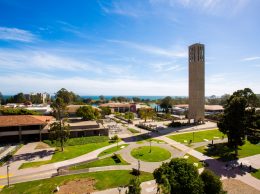UC Santa Barbara researchers received $9 million to further their efforts to get a better view of the human brain.
The National Science Foundation awarded the funding to the Next Generation Multiphoton Neuroimaging Consortium project, or NEMONIC, which includes UCSB researchers John Bowers, Michael Goard and Luke Theogarajan among its team of neuroscientists, electrical engineers, molecular biologists, neurologists, bioengineers and physicists. The collaboration aims to use longer wavelengths of light to image cell activity in the brain.
“The limit to understanding the brain is no longer the ability to store, process and analyze data,” Bridget Queenan, associate director of the UCSB Brain Initiative, said in a news release. “The fundamental barrier is the ability to see the brain in action. As neuroscientists, we would love to watch brain cells going about their daily business. We want to record all the cells all the time, but that’s just not possible with the existing technologies. Fundamentally, we need to invent new ways of seeing what brains are up to.”
The NSF is one of the lead agencies of the Brain Research through Advancing Innovative Neurotechnologies, or BRAIN, initiative launched by the federal government in 2013 to create new tools for understanding, diagnosing and repairing the brain. The funding also designated UCSB as a national NeuroNex Neurotechnology Hub.
The project aims to bring down the costs of imaging systems and develop new approaches to mapping the brain, which it will share across the neuroscience industry. Using photonic integrated circuits developed at UCSB, the team proposes to develop a smaller version of the multiphoton microscopy technology that is currently being used in labs to image the brains of animals.
“Bringing light and electronics together is what UCSB is known for,” said Rod Alferness, dean of the UCSB College of Engineering.
• Contact Marissa Nall at mnall@pacbiztimes.com.






 Print
Print Email
Email
















